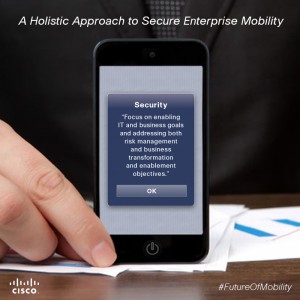 “It’s not secure enough… so we are not going to allow it to happen.”
“It’s not secure enough… so we are not going to allow it to happen.”
Does this phrase seem all too familiar?
Today, IT and business leaders are faced with the challenge of securing any user from any location on any device with access to any information. At times, it can be a daunting road to travel on the path towards true enterprise mobility security. This is especially true as the combination of sophisticated threats and new mobile capabilities and applications are continuing to shape the role and evolution of security controls and policies.
As the mobile endpoint becomes the new perimeter, how can organizations evolve their mobility security policies to mitigate risk? Is protecting information at the data or device level the way to keep employees and assets secure when users conduct business on untrusted networks?
Recently, I had a chance to participate in a new Future of Mobility podcast with Dimension Data’s Stefaan Hinderyckx, to discuss the biggest challenges our customers are seeing as they deploy enterprise mobility security solutions.
Many CSOs that Stefaan speaks with are seeing the clear and present danger of opening their networks, devices and applications to a new mobile world. Yet, many are not shying away from the benefits that enterprise mobility offers. They say:
“Mobility is inevitable. It’s happening and we need to embrace it and deliver it for the business.”
With this in mind, how can IT and business leaders address key challenges and embrace a holistic approach to secure enterprise mobility?
Complexity: There Are No Boundaries Anymore
One of the biggest challenges our customers are seeing is the increase in complexity as they work to meet business needs through mobility, all while keeping users and assets secure.
Simply put, there are no boundaries anymore. There is no place you can put a firewall to make things secure on the inside and insecure on the outside.
A major reason for this complexity is the result of approaching security in a siloed manner. It can be complex to try to secure the device, data on the device, the user and the network in a disparate way!
IT and business leaders need to work together to make the whole environment secure. It is no longer enough to find point solutions to data-centric or device-centric controls, the only way to be confident in your approach is to build a holistic strategy.
How Can You Start to Build a Holistic Strategy?
Like any business imperative—mobility security starts at the heart of your organization. It starts at the policy level and then develops into formal controls. It starts with you. Here are three considerations as you build a secure mobility strategy:
- Determine a Mobility Policy and Data Classification Model. IT leaders need to first identify what you need to secure. Stefaan states, “It is impossible to have a clearly defined security policy if you haven’t defined the crypticality of your assets and what you want to protect.”
- Define Access Control. Part of the challenge our customers have had over the years is that they have many, many different networks. They have a wireless network, a wired network, a VPN connection and more. With these multiple networks, it’s important to deploy one type of policy for access control over all of these networks.
- Introduce Mobile Device Management. While most of us are familiar with Mobile Device Management (MDM), this implementation can empower IT and InfoSec teams to separate data from personal and company-owned assets and issue controls and policies—whether users are bringing a device from home or using a company-issued device.
According to a recent IDC whitepaper, taking a strategic and holistic approach to enterprise mobility will be essential as organizations “focus on enabling IT and business goals and addressing both risk management and business transformation and enablement objectives.”
As IT and business leaders work to adopt and deploy this holistic approach to securing enterprise mobility, they will be able to reap the many benefits that true mobility offers. They can be better positioned to take advantage of the $19 trillion of Internet of Everything value at stake, stay competitive in the marketplace and enable business transformation.
How will you adopt a holistic approach to enterprise mobility security? Leave a comment below and join the conversation, #FutureOfMobility.
Additional Resources:
- Listen to the podcast: A Holistic Approach to Secure Enterprise Mobility featuring Cisco’s Gordon Thomson and Stefaan Hinderyckx, Dimension Data.
- What are the real opportunities and risks of mobility? Learn more in the recent blog series with Dimension Data.
- View A Holistic Approach to Secure Enterprise Mobility SlideShare highlights.
- Subscribe to the Future of Mobility Podcast Channel via iTunes.


CONNECT WITH US